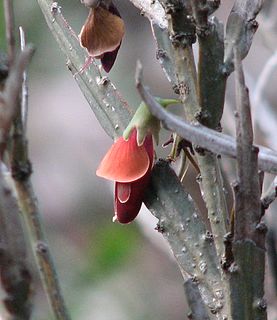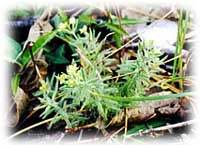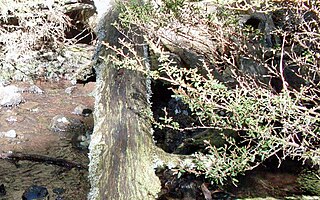
Leptospermum is a genus of shrubs and small trees in the myrtle family Myrtaceae commonly known as tea trees, although this name is sometimes also used for some species of Melaleuca. Most species are endemic to Australia, with the greatest diversity in the south of the continent, but some are native to other parts of the world, including New Zealand and Southeast Asia. Leptospermums all have five conspicuous petals and five groups of stamens which alternate with the petals. There is a single style in the centre of the flower and the fruit is a woody capsule.

Galium verum is a herbaceous perennial plant of the family Rubiaceae. It is widespread across most of Europe, North Africa, and temperate Asia from Palestine, Lebanon and Turkey to Japan and Kamchatka. It is naturalized in Tasmania, New Zealand, Canada, and the northern half of the United States. It is considered a noxious weed in some places.

Templetonia is a genus of flowering plants in the family Fabaceae. They are native to Australia. The genus is named in honour of John Templeton, an Irish naturalist and botanist.

Galium album, the white bedstraw or hedge bedstraw, is a herbaceous annual plant of the family Rubiaceae.

Hovea is a genus of perennial shrubs which are native to Australia. Species from this genus are occasionally cultivated as ornamental plants. The genus name honours Anton Pantaleon Hove, a Polish plant collector.

Goodia is a genus in the pea family, Fabaceae.

Bossiaea is a genus of flowering plants in the pea family Fabaceae, consisting of about 70 species which are native to Australia. The genus is named in honour of Joseph Hugues Boissieu La Martinière, a botanist on La Pérouse's expedition to Australia.

Grevillea acanthifolia, commonly known as the Acanthus-leaved grevillea, is a plant in the family Proteaceae and is endemic to New South Wales. It is a shrub with stiff, prickly, divided leaves and pink to purple "toothbrush" flowers.

Galium spurium, the stickwilly or false cleavers, is a plant species of the Rubiaceae. It is widespread across Europe, Asia, Africa and Canada, and is naturalized in Australia. It is considered a noxious weed in many places.

Galium californicum is a species of flowering plant in the coffee family known by the common name California bedstraw.

Galium trifidum is a species of flowering plant in the coffee family, known by the common name three-petal bedstraw. It grows widespread in the arctic, temperate and subtropical regions of the Northern Hemisphere: northern and central Asia, northern and eastern Europe and much of North America.

Leptospermum polygalifolium, commonly known as tantoon, jellybush or yellow tea tree, is a species of shrub or tree of the family Myrtaceae that is endemic to eastern Australia, including Lord Howe Island. It has thin bark, elliptical leaves, white flowers arranged singly on short side shoots and fruit that remain on the plant for a few years.

Persoonia hirsuta, commonly known as the hairy geebung or hairy persoonia, is a plant in the family Proteaceae and is endemic to eastern New South Wales. It is a hairy, spreading to low-lying shrub with linear, lance-shaped or spatula-shaped leaves and yellow or orange flowers arranged singly or in groups of up to ten on a rachis up to 20 mm (0.79 in) long.

Synaphea spinulosa is a species of small shrub in the flowering plant family Proteaceae. It is endemic to Western Australia. Together with Acacia truncata, it was the first Australian endemic to be scientifically described and named, and the specimen upon which that description is based is the oldest extant specimen of an Australian plant, and very likely among the first Australian plant specimens ever collected.

Platylobium montanum is a shrub species that is endemic to Australia. It is a member of the family Fabaceae and of the genus Platylobium. The species was first formally described in 2011.

Leptospermum polygalifolium subsp. montanum known as the mountain tea tree or tantoon is a shrub or small tree found in eastern Australia. The original specimen was collected in 1912 near Yarrowitch. This plant is a sub-species of the Tantoon of the Myrtle family. It resembles other plants commonly referred to as "tea trees" or "paperbarks". The sub-species term montanum refers to its habitat of high altitudes. Polygalifolium is derived from Latin, referring to the resemblance of the leaves to certain members of the Polygala.

Grevillea ramosissima, commonly known as fan grevillea, is a shrub species of the family Proteaceae. It is native to south-eastern Australia.

Galium mexicanum is a species of plant in the family Rubiaceae. It has a widespread distribution from British Columbia south to Ecuador.
Galium leptogonium is a plant species in the family Rubiaceae. Common name is rock bedstraw. It is found only in Australia but widespread there, found in every state except Tasmania.
Galium orizabense is a species of plants in the family Rubiaceae, named for the town of Orizaba in Veracruz, where the first collections of the species were made. The species is native to Mexico, Costa Rica, Guatemala, Panamá, Venezuela, Colombia, and Hispaniola, plus widely scattered locations in the southeastern United States.

















